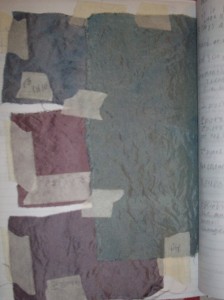How to get repeatable colours with natural dyes
Natural dyes are beautiful, sustainable, renewable. Each natural dye is made up of many different colour molecules which give natural dyes their beauty and make them look flattering on all skin types. While chemical dyes are toxic, damaging to the environment, and clash with many skin types because of their single colour molecule, natural dyes are kind. In a world that demands uniformity and replication, natural dyes become more beautiful in their uniqueness, and depth of shade.
Often as a natural dyer you will be happy with the colours you get and desire their distinctiveness, however, at times you may want to repeat a colour. By keeping tract of your method with each dye bath, repeatable natural dye colours will be within your reach.
Natural dye colours depend on many variables which make exact matching almost, but not quite, impossible. Keeping track of these variables in your dye journal will make your dyeing easier.
Some of the variables include:
- growing conditions
- the pH of the vat throughout the dyeing process
- the mordant(s) used
- The amount of fibre and dyestuff used
- the type of fibre dyed
- the pH at which the fibre is washed
While most of the variables can be controlled, they will not be remembered if you want to repeat a colour, three months or even three years from now. When testing natural dyes it is good to keep a natural dye journal. A natural dye journal can be used to record the controlable variables, making colours repeatable and reliable.
Some variables to record:
- the time and type of extraction used
- the pH of the dye vat
- the temperature of the vat
- the amount of dyestuff used
- the amount of fibre dyed in each vat till exhaustion
- the mordant(s) used
- and samples of the dyed and washed fibre. If more than one mordant or fibre is used, keep samples of each.
An example of a journal entry to help you with your experimentation
Keeping track of these things will enable you to get a very close approximation to your original colours. As an example, I designed a template for a dye bath made with bark from a larch tree. The following is the pattern I would follow for my dye experiments. As the experiment is still in process, the numbers, pHs and times are not exact.
Initial water pH: 7
Type of dye stuff – Larch bark
Amount of dye stuff – 50gms
Length of time for extraction – 14 days in pH neutral water
Amount of time “cooked” before dyestuff removal — 3 hours at simmer
Mordant—10 % Alum and 3 % Cream of Tartar (per weight of wool)
Fibre – wool
Amount of fibre—50 gms in first vat, 50gms in second vat heated till exhausted
Amount of time in dye vat – overnight, started at simmer, cooled to room temperature by morning, same for both vats
Washed — slightly alkaline water due to soap, rinsed pH neutral
(I would include on the page in my dye journal a place to put samples of the dyed fiber.)
Samples of dyed fibre
(Punch holes in page for fibre sample)
First batch Second batch
Using a journal such as the above example will make your natural dye colours repeatable, almost to the exact shade, the only uncontrollable variable being the growing conditions of the dye stuffs, which change from year to year.
Natural dyes are beautiful! And with a little care they can be colourfast and repeatable, too.
Your turn:
How do you keep a record of your natural dyeing? Do you use a notebook, or an art journal, or something else? Leave a comment.

[…] don’t forget to record your harvest time and technique so that you can get similar results next […]